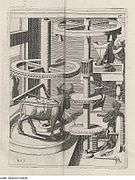Pascal's calculator
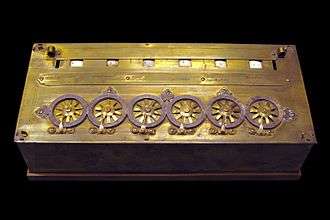
Pascal's calculator is a mechanical calculator invented by Blaise Pascal in the early 17th century. It was called the arithmetic machine and later became known as the Pascaline. Pascal was led to develop a calculator by the laborious arithmetical calculations required by his father's work as supervisor of taxes in Rouen.[1] He designed the machine to add and subtract two numbers directly and to perform multiplication and division through repeated addition or subtraction.
Pascal's calculator was especially successful in the design of its carry mechanism, which adds 1 to 9 on one dial, and when it changes from 9 to 0, carries 1 to the next dial. His innovation made each digit independent of the state of the others, which enabled multiple carries to rapidly cascade from one digit to another regardless of the machine's capacity. Pascal was also the first to shrink and adapt for his purpose a lantern gear, used in turret clocks and water wheels, which could resist the strength of any operator input with very little added friction.
Nine Pascal calculators have been made,[2] including the first surviving mechanical calculator from the 17th century. Most of them are on display in European museums.
Overview
Pascal designed the machine in 1642,[3][4] and after 50 prototypes, he presented it to the public in 1645, dedicating it to Pierre Séguier, then chancellor of France.[5] Pascal built around twenty more machines during the next decade, many of which improved on his original design. In 1649, King Louis XIV of France gave Pascal a royal privilege (similar to a patent), which gave him the exclusive right to design and manufacture calculating machines in France.
Other later developments often reflected aspects of the Pascaline, either because they were actually inspired by it or at least shaped by the same historical influences which led Pascal to develop his invention. Gottfried Leibniz invented his Leibniz wheels after 1671 after trying to add an automatic multiplication feature to the Pascaline.[6] In 1820, Thomas de Colmar designed his arithmometer. It is not at all clear whether he ever saw Leibniz's device, but he either re-invented it or utilised Leibniz's invention of the step drum. The arithmometer was the first mechanical calculator strong enough and reliable enough to be used daily in an office environment.
Pascal was also influential in seeking to commercialise his machine (albeit with only limited success). Although other forms of calculation (using the abacus, calculi, counting boards, and other means of ready reckoning) were in widespread use, Pascal's machine symbolised a step forward compatible with the increasing interest in using machines to displace tedious work. In this sense his invention was an important step in the development of mechanical calculators first in Europe and then all over the world. This development culminated, three centuries later, in the invention of the microprocessor, developed for a Busicom calculator in 1971. Today, microprocessors are at the heart of all computers and embedded systems.[7]
History
Precursors
Aids to calculations
The abacus, probably invented in Sumer between 2700 and 2300 BC, is an early computing device invented by humans. Whilst it has no automatically moving parts or gears, the movement of its beads on structured rods provides a powerful and efficient mechanism for carrying out all four arithmetic operations. As late as the mid-20th century the speed of such operations on an abacus could rival or exceed the speed of the same computations performed on the latest electric calculating machines.[8] Over centuries, support for arithmetical operations was provided either by the abacus or by other counting technologies such as the counting board and calculi and "the pen and jeton". In 1617 John Napier built on a known method of "lattice multiplication" to publish his "rods" or Napier's Bones which, appearing in a range of forms over subsequent centuries, were found to considerably facilitate the performance of multiplication and division, especially by those not well equipped to memorise multiplication tables.
Analog computers, automatons
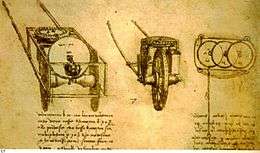
A short list of other precursors to the mechanical calculator must include the Greek Antikythera mechanism from around 100 BC, an out of place, unique, geared mechanism, followed more than a millennium later by early mechanical clocks and geared astrolabes; These machines were all made of toothed gears linked by some sort of carry mechanisms. They belong to a group of mechanical analog computers which, once set, are only modified by the continuous and repeated action of their actuators (crank handle, weight, wheel...)
Some measuring instruments and automatons were also precursors to the calculating machine.

An odometer, an instrument for measuring distances, was first described around 25 BC by the Roman engineer Vitruvius in the tenth volume of his De architectura. It was made of a set of toothed gears linked by a carry mechanism; the first one was driven by one of the chariot wheels and the last one dropped a small pebble in a bag for each Roman mile traveled.[9]
A Chinese text of the third century AD describes a chariot equipped with a geared mechanism that operated two wooden figures. One would strike a drum for every Chinese Li traveled; the other one would strike a gong for every ten Li traveled.[10]
Around the end of the tenth century, the French monk Gerbert d'Aurillac, whose abacus was used to teach the Hindu-Arabic numeral system to Europeans,[11] brought back from Spain the drawings of a brazen head, invented by the Moors, which answered Yes or No to the questions it was asked (binary arithmetic).[12]
Again in the thirteenth century, the monks Albertus Magnus and Roger Bacon built mechanical speaking heads made of earthenware without any further development (Albertus Magnus complained that he had wasted forty years of his life when Thomas Aquinas, terrified by this speaking machine, destroyed it.[13]) .
The Italian polymath Leonardo da Vinci drew an odometer before 1519.
In 1525, the French craftsman Jean Fernel built the first pedometer. It was made in the shape of a watch and had four dials (units, tens, hundreds, thousands) linked by a single-tooth carry mechanism.[14]
In 1623 and 1624, Wilhelm Schickard, in two letters that he sent to Kepler, reported his design and construction of what he referred to as an arithmeticum organum (“arithmetical instrument”) that he had invented,[15] but he also described it as a "Rechen Uhr" (calculating clock) in his note to an artisan who was constructing it. It was capable of facilitating all four arithmetic operations. The notes on Schickard's invention did not provide full details of the mechanism, and based on what was shown it may well have had limitations in the effectiveness of its operation (discussed below). Other designs for calculating machines that followed in the 17th century included the very different and in some ways superior (but in other ways less ambitious) conception by Pascal (discussed below) and the designs of Tito Burattini, Samuel Morland and René Grillet).[16] A later more sophisticated calculating clock was built by the Italian Giovanni Poleni in the 18th century (1709). It was a two-motion calculating clock where the numbers are first inscribed and then processed (see Pascal versus Schickard).
Achievements
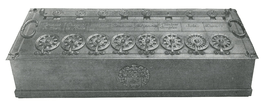

Pascal began to work on his calculator in 1642, when he was 19 years old. He had been assisting his father, who worked as a tax commissioner, and sought to produce a device which could reduce some of his workload. Pascal received a Royal Privilege in 1649 that granted him exclusive rights to make and sell calculating machines in France. By 1654 he had sold about twenty machines, but the cost and complexity of the Pascaline was a barrier to further sales and production ceased in that year. By that time Pascal had moved on to the study of religion and philosophy, which gave us both the Lettres provinciales and the Pensées.
Besides being the first calculating machine made public during its time, the pascaline is also:
- the only operational mechanical calculator in the 17th century.[17]
- the first calculator to have a controlled carry mechanism that allowed for an effective propagation of multiple carries[18]
- the first calculator to be used in an office (his father's to compute taxes)
- the first calculator commercialized (with around twenty machines built)[2]
- the first calculator to be patented (royal privilege of 1649)[19]
- the first calculator to be described in an encyclopaedia (Diderot & d'Alembert, 1751):
"...The first arithmetic machine presented to the public was from Blaise Pascal, born in Clermont, Auvergne on June 19, 1623 ; he invented it at the age of 19. Other machines have been designed since which, in the judgement of Mr of the Academy of Sciences, seem to have more practical advantages ; but Pascal's machine is the oldest one ; it could have served as model to all the others ; this is why we preferred it."[20]
- the first calculator sold by a distributor:
"Mr de Roberval ... located in the college Maitres Gervais ... every morning until 8..."[21]
Competing designs
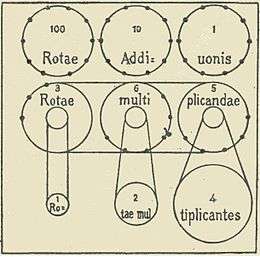
Gottfried Leibniz started to work on his own calculator after Pascal's death. He first tried to build a machine that could multiply automatically while sitting on top of the Pascaline, assuming (wrongly) that all the dials on Pascal's calculator could be operated at the same time. Even though this could not be done, it was the first time that a pinwheel was described and used in the drawing of a calculator.
He then devised a competing design, the Stepped Reckoner which was meant to perform additions, subtractions and multiplications automatically and division under operator control. Leibniz struggled for forty years to perfect this design and produced two machines, one in 1694 and one in 1706.[22] Only the machine built in 1694 is known to exist; it was rediscovered at the end of the 19th century, having spent 250 years forgotten in an attic at the University of Göttingen.[22]
The German calculating-machine inventor Arthur Burkhardt was asked to attempt to put Leibnitz' machine in operating condition. His report was favorable except for the sequence in the carry.[23] and "therefore, especially in the case of multiple carry transfers, the operator had to check the result and manually correct the possible errors".[24] Leibniz had not succeeded in creating a calculator that worked properly, but he had invented the Leibniz wheel, the principle of a two-motion mechanical calculator. He was also the first to have cursors to inscribe the first operand and a movable carriage for results.
There were five additional attempts at designing "direct entry" calculating machines in the 17th century (including the designs of Tito Burattini, Samuel Morland and René Grillet)).[16]
Around 1660 Claude Perrault designed an abaque rhabdologique that is often mistaken for a mechanical calculator because it has a carry mechanism in between the numbers. But it is actually an abacus, since it requires the operator to handle the machine differently when a carry transfer takes place.[25]
Pascal's calculator was the most successful mechanical calculator developed in the 17th century for the addition and subtraction of large numbers.[26]
Calculating machines did not become commercially viable until 1851, when Thomas de Colmar released, after thirty years of development, his simplified arithmometer, the first machine strong enough to be used daily in an office environment. The Arithmometer was designed around Leibniz wheels and initially used Pascal's 9's complement method for subtractions.
Tercentenary celebration
The tercentenary celebration of Pascal's invention of the mechanical calculator occurred during WWII when France was occupied by Germany and therefore the main celebration was held in London, England. Some of the speeches given best describe his achievement:
...when he invented the calculating machine—essentially a practical instrument—Pascal was already well known in the realm of pure mathematics. His perseverance with this invention helped one to appreciate more fully the character of Pascal. He had to fight not only ill-health but also the ignorance of his time, for his conception far out-stripped the mechanical experience and ability of those to whom the work was entrusted. It was not until Pascal had made more than fifty models that he achieved his final design.
The invention of the calculating machine illustrated Pascal's extraordinary creative imagination, allied with mathematical genius and precision, and tempered with critical penetration. These qualities were characteristic of the man throughout his life.
— Prof. René Cassin, Pascal tercentenary celebration, London, (1942)[27]
Pascal's invention of the calculating machine, just three hundred years ago, was made while he was a youth of nineteen. He was spurred to it by seeing the burden of arithmetical labor involved in his father's official work as supervisor of taxes at Rouen. He conceived the idea of doing the work mechanically, and developed a design appropriate for this purpose ; showing herein the same combination of pure science and mechanical genius that characterized his whole life. But it was one thing to conceive and design the machine, and another to get it made and put into use. Here were needed those practical gifts that he displayed later in his inventions....
In a sense, Pascal's invention was premature, in that the mechanical arts in his time were not sufficiently advanced to enable his machine to be made at an economic price, with the accuracy and strength needed for reasonably long use. This difficulty was not overcome until well on into the nineteenth century, by which time also a renewed stimulus to invention was given by the need for many kinds of calculation more intricate than those considered by Pascal.
— S. Chapman, Pascal tercentenary celebration, London, (1942)[1]

Fields of application
Pascalines came in both decimal and non-decimal varieties, both of which can be viewed in museums today. They were designed for use by scientists, accountants and surveyors. The simplest Pascaline had five dials; later variants had up to ten dials.
The contemporary French currency system used livres, sols and deniers with 20 sols to a livre and 12 deniers to a sol. Length was measured in toises, pieds, pouces and lignes with 6 pieds to a toise, 12 pouces to a pied and 12 lignes to a pouce. Therefore, the pascaline needed wheels in base 6, 10, 12 and 20. Non-decimal wheels were always located before the decimal part.
In an accounting machine (..10,10,20,12), the decimal part counted the number of livres (20 sols), sols (12 deniers) and deniers. In a surveyor's machine (..10,10,6,12,12), the decimal part counted the number of toises (6 pieds), pieds (12 pouces), pouces (12 lignes) and lignes. Scientific machines just had decimal wheels.
| Machine Type | All the other wheels | 4th wheel | 3rd wheel | 2nd wheel | 1st wheel |
|---|---|---|---|---|---|
| Decimal / Scientific |
base 10 Ten thousands... |
base 10 Thousands |
base 10 Hundreds |
base 10 Tens |
base 10 Units |
| Accounting | base 10 Hundreds... |
base 10 Tens |
base 10 Livres |
base 20 Sols |
base 12 Deniers |
| Surveying | base 10 Tens ... |
base 10 Toises |
base 6 Pieds |
base 12 Pouces |
base 12 Lignes |
| The decimal part of each machine is highlighted | |||||
The metric system was adopted in France on December 10, 1799, by which time Pascal's basic design had inspired other craftsmen, although with a similar lack of commercial success.
Known machines
Most of the machines that have survived the centuries are of the accounting type. Seven of them are in European museums, one belongs to the IBM corporation and one is in private hands.
| Location |
Country |
Machine Name |
Type |
Wheels |
Configuration |
Notes |
|---|---|---|---|---|---|---|
| CNAM museum Paris | France | Chancelier Séguier | Accounting | 8 | 6 x 10 + 20 + 12 | |
| CNAM museum Paris | France | Christina, Queen of Sweden | Scientific | 6 | 6 x 10 | |
| CNAM museum Paris | France | Louis Périer | Accounting | 8 | 6 x 10 + 20 + 12 | Louis Périer, Pascal's nephew, offered it to the Académie des sciences de Paris in 1711. |
| CNAM museum Paris | France | Late (Tardive) | Accounting | 6 | 4 x 10 + 20 + 12 | This machine was assembled in the 18th century with unused parts.[28] |
| musée Henri Lecoq[29] Clermont-Ferrand | France | Marguerite Périer | Scientific | 8 | 8 x 10 | Marguerite (1646–1733) was Pascal's goddaughter.[30] |
| Musée Henri Lecoq Clermont-Ferrand | France | Chevalier Durant-Pascal | Accounting | 5 | 3 x 10 + 20 + 12 | This is the only known machine that came with a box. This is the smallest machine. Was it meant to be portable? |
| Mathematisch-Physikalischer salon,[31] Dresden | Germany | Queen of Poland | Accounting | 10 | 8 x 10 + 20 + 12 | The second wheel from the right has a wheel with 10 spokes contained in a fixed wheel with 20 segments. This could be attributed to a bad restoration. |
| Léon Parcé collection | France | Surveying | 8 | 5 x 10 + 6 + 12 + 12 | This machine was bought as a broken music box in a French antique shop in 1942. | |
| IBM collection[32] | USA | Accounting | 8 | 6 x 10 + 20 + 12 |
User interface

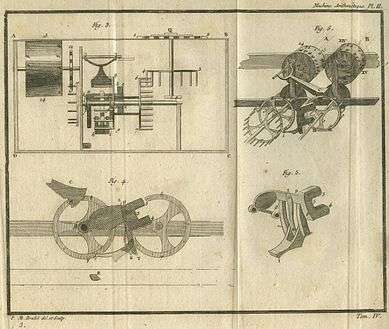
Overview
The calculator had spoked metal wheel dials, with the digit 0 through 9 displayed around the circumference of each wheel. To input a digit, the user placed a stylus in the corresponding space between the spokes and turned the dial until a metal stop at the bottom was reached, similar to the way a rotary telephone dial is used. This displayed the number in the windows at the top of the calculator. Then, one simply redialed the second number to be added, causing the sum of both numbers to appear in the accumulator.
Each dial is associated with a one-digit display window located directly above it, which displays the value of the accumulator for this position. The complement of this digit, in the base of the wheel (6, 10, 12, 20), is displayed just above this digit. A horizontal bar hides either all the complement numbers when it is slid to the top, or all the direct numbers when it is slid toward the center of the machine. It thereby displays either the content of the accumulator or the complement of its value.[33]
Since the gears of the calculator rotated in only one direction, negative numbers could not be directly summed. To subtract one number from another, the method of nine's complement was used. The only two differences between an addition and a subtraction are the position of the display bar (direct versus complement) and the way the first number is entered (direct versus complement).
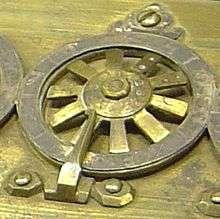
Input wheel
For a 10-digit wheel (N), the fixed outside wheel is numbered from 0 to 9 (N-1). The numbers are inscribed in a decreasing manner clockwise going from the bottom left to the bottom right of the stop lever. To add a 5, one must insert a stylus between the spokes that surround the number 5 and rotate the wheel clockwise all the way to the stop lever. The number displayed on the corresponding display register will be increased by 5 and, if a carry transfer takes place, the display register to the left of it will be increased by 1. To add 50, use the tens input wheel (second dial from the right on a decimal machine), to add 500, use the hundreds input wheel, etc...
Marks on two adjacent spokes
On all the wheels of all the known machines, except for the machine tardive,[34] two adjacent spokes are marked; these marks differ from machine to machine. On the wheel pictured on the right, they are drilled dots, on the surveying machine they are carved; some are just scratches or marks made with a bit of varnish,[35] some were even marked with little pieces of paper.[36]
These marks are used to set the corresponding cylinder to its maximum number, ready to be re-zeroed. To do so, the operator inserts the stylus in between these two spokes and turns the wheel all the way to the stopping lever. This works because each wheel is directly linked to its corresponding display cylinder (it automatically turns by one during a carry operation). To mark the spokes during manufacturing, one can move the cylinder so that its highest number is displayed and then mark the spoke under the stopping lever and the one to the right of it.
Inner wheel of complements
Four of the known machines have inner wheels of complements, which were used to enter the first operand in a subtraction. They are mounted at the center of each spoked metal wheel and turn with it. The wheel displayed in the picture above has an inner wheel of complements but the numbers written on it are barely visible. On a decimal machine, the digits 0 through 9 are carved clockwise, with each digit positioned between two spokes so that the operator can directly inscribe its value in the window of complements by positioning his stylus in between them and turning the wheel clockwise all the way to the stop lever.[37] The marks on two adjacent spokes flank the digit 0 inscribed on this wheel.
Quotient wheel
On four of the known machines, above each wheel, a small quotient wheel is mounted on the display bar. These quotient wheels, which are set by the operator, have numbers from 1 to 10 inscribed clockwise on their peripheries (even above a non-decimal wheel). Quotient wheels seem to have been used during a division to memorize the number of times the divisor was subtracted at each given index.[38]
Inner mechanism
Shrinking a turret clock mechanism
Pascal went through 50 prototypes before settling on his final design; we know that he started with some sort of calculating clock mechanism that used springs which apparently "works by springs and which has a very simple design", was used "many times" and remained in "operating order". Nevertheless, "while always improving on it" he found reason to try to make the whole system more reliable and robust[39] Eventually he adopted a component of very large clocks, shrinking and adapting for his purpose the robust gears that can be found in a turret clock mechanism called a lantern gear, itself derived from a water wheel mechanism. This could easily handle the strength of an operator input.[40]
|
In the colored drawing above, the blue gear (input) meshes with the yellow gears (processing), which themselves drive the red gear (output). The intersection of two perpendicular cylinders is one point and therefore, in theory, the blue gear and the yellow gear mesh in one single point. Pascal designed a gear that could easily take the strength of the strongest operator and yet added almost zero friction to the entire mechanism.
Pawl and Ratchet
Pascal adapted a pawl and ratchet mechanism to his own turret wheel design; the pawl prevents the wheel from turning counterclockwise during an operator input, but it is also used to precisely position the display wheel and the carry mechanism for the next digit when it is pushed up and lands into its next position. Because of this mechanism, each number displayed is perfectly centered in the display window and each digit is precisely positioned for the next operation. This mechanism would be moved six times if the operator dialed a six on its associated input wheel.
Carry mechanism
The sautoir
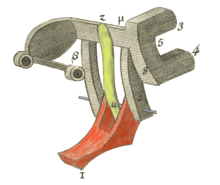
The sautoir is the centerpiece of the pascaline's carry mechanism. In his "Avis nécessaire...", Pascal wrote:
... as for the ease of use of this ... movement ... moving one thousand or even ten thousand wheels if they were there, each one performing their motion perfectly, is as easy as moving only one (I don't know if, after the principle that I perfected to design this device, there is another one left to be found in nature)...[41]
A machine with 10,000 wheels would work as well as a machine with two wheels because each wheel is independent of the other. When it is time to propagate a carry, the sautoir, under the sole influence of gravity,[42] is thrown toward the next wheel without any contact between the wheels. During its free fall the sautoir behaves like an acrobat jumping from one trapeze to the next without the trapezes touching each other ("sautoir" comes from the French verb sauter, which means to jump). All the wheels (including gears and sautoir) have therefore the same size and weight independently of the capacity of the machine.
Pascal used gravity to arm the sautoirs. One must turn the wheel five steps from 4 to 9 in order to fully arm a sautoir, but the carry transfer will move the next wheel only one step. Thus much extra energy is accumulated during the arming of a sautoir.
All the sautoirs are armed by either an operator input or a carry forward. To re-zero a 10,000-wheel machine, if one existed, the operator would have to set every wheel to its maximum and then add a 1 to the "unit" wheel. The carry would turn every input wheel one by one in a very rapid Domino effect fashion and all the display registers would be reset.
The three phases of a carry transmission
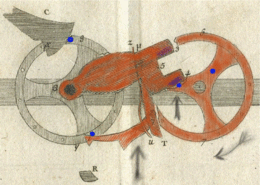
The animation on the right shows the three phases of a carry transmission.
- The first phase happens when the display register goes from 4 to 9. The two carry pins (one after the other) lift the sautoir pushing on its protruding part marked (3,4,5). At the same time the kicking pawl (1) is pulled up, using a pin on the receiving wheel as guidance, but without effect on this wheel because of the top pawl/ratchet (C).
- The second phase starts when the display register goes from 9 to 0. The kicking pawl passes its guiding pin and its spring (z,u) positions it above this pin ready to push back on it. The sautoir keeps on moving up and suddenly the second carry pin drops it. The sautoir falls of its own weight.
- The kicking pawl (1) pushes the pin on the receiving wheel and starts turning it. The upper pawl/ratchet (C) is moved to the next space. The operation stops when the protruding part (T) hits the buffer stop (R). The upper pawl/ratchet (C) positions the entire receiving mechanism in its proper place.
- During the first phase, the active wheel touches the one that will receive the carry through the sautoir, but it never moves it or modifies it and therefore the status of the receiving wheel has no impact whatsoever on the active wheel.
- During the second phase, the sautoir and the two wheels are completely disconnected.
- During the third phase the sautoir, which no longer touches the active wheel, adds one to the receiving wheel.
Operations
Principle
The Pascaline is a direct adding machine (it has no crank), so the value of a number is added to the accumulator as it is being dialed in. By moving a display bar, the operator can see either the number stored in the calculator or the complement of its value. Subtractions are performed like additions using some properties of 9's complement arithmetic.
9's complement
The 9's complement of any one digit decimal number d is 9 – d. So the 9's complement of 4 is 5 and the 9's complement of 9 is 0. Similarly the 11's complement of 3 is 8.
In a decimal machine with n dials the 9's complement of a number A is:
- CP(A) = 10n – 1 – A
and therefore the 9's complement of (A – B) is:
- CP(A – B) = 10n −1 – (A – B) = 10n −1 – A + B = CP(A) + B
- CP(A – B) = CP(A) + B
In other words, the 9's complement of the difference of two numbers is equal to the sum of the 9's complement of the minuend added to the subtrahend. The same principle is valid and can be used with numbers composed of digits of various bases (base 6, 12, 20), like in the surveying or the accounting machines.
This can also be extended to:
- CP(A – B – C – D) = CP(A) + B + C + D
This principle applied to the pascaline:
| CP(A): | First the complement of the minuend is entered. The operator can either use the inner wheels of complements or dial the complement of the minuend directly. The display bar is shifted to show the complement's window so that the operator sees the direct number displayed because CP(CP(A)) = A. |
| B: | Then the second number is dialed in and adds its value to the accumulator. |
| CP(A – B): | The result (A – B) is displayed in the complement window because CP(CP(A – B)) = A – B. The last step can be repeated as long as the subtrahend is smaller than the minuend displayed in the accumulator. |
Resetting the machine
The machine has to be re-zeroed before each new operation.
To reset his machine, the operator has to set all the wheels to their maximum, using the marks on two adjacent spokes, and then add 1 to the rightmost wheel.[43]
The method of re-zeroing that Pascal chose, which propagates a carry right through the machine, is the most demanding task for a mechanical calculator and proves, before each operation, that the machine is fully functional.
This is a testament to the quality of the Pascaline because none of the 18th century criticisms of the machine mentioned a problem with the carry mechanism and yet this feature was fully tested on all the machines, by their resets, all the time.[44]
| Re-zero | Set all the wheels to their maximum using the marks on two adjacent spokes. Every single wheel is ready for a carry transfer. |
| ||||||||||
| Add 1 to the right-most wheel. Each wheel sends its sautoir to the next one, the zeros appear one after another, like in a domino effect, from right to left. |
| |||||||||||
Addition
Additions are performed with the display bar moved closest to the edge of the machine, showing the direct value of the accumulator.
After re-zeroing the machine, numbers are dialed in one after the other.
The following table shows all the steps required to compute 12,345 + 56,789 = 69,134
| Addition | The machine is at zero, the operator enters 12,345. |
| ||||||||||
| The operator enters the second operand: 56,789. If he starts with the rightmost number, the second wheel will go from 4 to 5, during the inscription of the 9, because of a carry transmission.... |
| |||||||||||
Subtraction
Subtractions are performed with the display bar moved closest to the center of the machine showing the complement value of the accumulator.
The accumulator contains CP( A ) during the first step and CP( A – B) after adding B. In displaying that data in the complement window, the operator sees CP( CP( A)) which is A and then CP(CP( A – B )) which is (A – B). It feels like an addition since the only two differences in between an addition and a subtraction are the position of the display bar (direct versus complement) and the way the first number is entered (direct versus complement).
The following table shows all the steps required to compute 54,321 – 12,345 = 41,976
| Change display space | Move the display bar down to uncover the complement part of each result cylinder. From this point on, every number dialed into the machine adds its value to the accumulator and therefore decreases the total displayed in the complement window. |
| ||||||||||
| Subtraction | Enter the 9's complement of the minuend. The operator can either use the inner wheels of complements or dial the 9's complement of 54,321 (45,678) directly. |
| ||||||||||
| Dial the subtrahend (12,345) on the spoked metal wheels. This is an addition. The result, 41,976, is in the 9's complement window. |
| |||||||||||
Pascal versus Schickard

History
From the introduction of the Pascaline and for more than three centuries Pascal was known as the inventor of the mechanical calculator. Then, in 1957, Franz Hammer, a biographer of Johannes Kepler, challenged this fact by announcing that the drawings of a previously unknown working calculating clock, predating Pascal's work by twenty years, had been rediscovered after three centuries in two letters that Wilhelm Schickard had written to his friend Johannes Kepler in 1623 and 1624.[45] The 1624 letter stated that the first machine to be built by a professional had been destroyed in a fire during its construction and that he was abandoning his project.[46]
Franz Hammer asserted that because these letters had been lost for three hundred years, Blaise Pascal had been incorrectly called[47] and celebrated as[48] the inventor of the mechanical calculator during all this time.
Published since 1718
After careful examination it was found, in contradistinction to Franz Hammer's understanding, that Schikard's drawings had been published at least once per century starting from 1718.[49] The other part of Franz Hammer's claim, which may also be erroneous, was that the two letters contained the drawings of a calculating clock that actually worked. This of course may have been a deficiency in the completeness of the fragmentary notes that have survived, rather than the actual machine built under Schickard's design, which he certainly reported to Kepler as working.
Addition of wheels and springs
Bruno von Freytag Loringhoff, a mathematics professor at the University of Tübingen built the first replica of Schickard's machine but not without adding wheels and springs to finish the design:
This simple-looking device actually presents a host of problems to anyone attempting to construct an adding machine based on this principle. The major problem is caused by the fact that the single tooth must enter into the teeth of the intermediate wheel, rotate it 36 degrees (one tenth of a revolution), and exit from the teeth, all while only rotating 36 degrees itself. The most elementary solution to this problem consists of the intermediate wheel being, in effect, two different gears, one with long and one with short teeth together with a spring-loaded detente (much like the pointer used on the big wheel of the gambling game generally known as Crown and Anchor) which would allow the gears to stop only in specific locations. It is not known if Schickard used this mechanism, but it certainly works well on the reproductions constructed by von Freytag Loringhoff.— Michael R. Williams[50], History of Computing Technology, IEEE (1997)
This detail is not described in the two surviving Schickard's letters and drawings but as these were merely notes this cannot be taken to mean that he was misleading Kepler when he stated that he had built such a machine and it worked. As Schickard noted "...Arithmeticum organum alias delineabo accuratius, nunc et festinate hoc have" or, in English: "..I will describe the computer more precisely some other time, now I don't have enough time."[51] Amongst the detail omitted could well have been the détente. The role of a détente catchment was widely understood by clockmakers, and as Schickard had turned to clockmakers to construct his machine, it is highly likely that this type of approach would have been included before the finalisation of his machine.
Inadequate carry mechanism
A problem in the operation of the Schickard machine, based on the surviving notes, was found after the replicas were built:
... it is almost certain that Pascal would not have known of Schickard's machine ...
Pascal seems to have realized right from the start that the single-tooth gear, like that used by Schickard, would not do for a general carry mechanism. The single-tooth gear works fine if the carry is only going to be propagated a few places but, if the carry has to be propagated several places along the accumulator, the force needed to operate the machine would be of such magnitude that it would do damage to the delicate gear works.— Michael R. Williams, History of Computing Technology, IEEE (1997)[52]
Schickard's machine used clock wheels which were made stronger and were therefore heavier, to prevent them from being damaged by the force of an operator input. Each digit used a display wheel, an input wheel and an intermediate wheel. During a carry transfer all these wheels meshed with the wheels of the digit receiving the carry. The cumulative friction and inertia of all these wheels could "...potentially damage the machine if a carry needed to be propagated through the digits, for example like adding 1 to a number like 9,999".[53]
The great innovation in Pascal's calculator was that it was designed so that each input wheel is totally independent from all the others and carries are propagated in sequence. Pascal chose, for his machine, a method of re-zeroing that propagates a carry right through the machine.[43] It is the most demanding operation to execute for a mechanical calculator and proved, before each operation, that the carry mechanism of the Pascaline was fully functional. This could be taken as a testament to the quality of the Pascaline because none of the 18th century criticisms of the machine mentioned a problem with the carry mechanism and yet this feature was fully tested on all the machines, by their resets, all the time.[44] Alternatively, it could be taken as a prudent test of the functioning of the machine prior to use since, as experimenting with replicas suggests, it is not too hard for such designs, even built with modern tools, to go out of adjustment.
Conclusion
Even though Schickard designed his machine twenty years earlier a controversy continues as to whether Schickard or Pascal should be described as the inventor of the mechanical calculator. On the one hand, we have from Schickard's drawings the first description of a mechanical calculator. But the carry mechanism of Schickard's calculator is not fully described (which does not necessarily mean there was not one well worked out) and from what is described in the surviving notes it appears that if a carry was required across several places simultaneously the mechanism would jam. On the other hand, examples of Pascal's calculator survive and modern replicas have been made which work perfectly.[54] But Pascal designed and built his machines later than Schickard. In the end, the answer to the question of who should be recognised as having primacy in this invention depends on precisely how that question is phrased.
The two machines were essentially different in that Pascal's machine was designed primarily for addition (and with the use of complementary numbers) for subtraction. The adding machine in Schickard's design may have jammed in the unusual case of a carry being required across too many dials, but it could smoothly subtract by reversing the motion of the input dials, in a way that was not possible in the Pascaline. (Experiments with replicas show that in the event of a jam when a carry is attempted across more than (say) three dials, it is obvious to the operator who may intervene to assist the machine to perform the additional carries. This is not as efficient as with the Pascaline, but it is not a fatal deficiency.) The Schickard adding machine also has provision for an audible warning when an output was too large for the available dials. This was not provided for in the Pascaline.
In any case, in contradistinction to the aims of Pascal—which appear to have been to create a smoothly functioning adding machine for use by his father initially, and later for commercialisation—the adding machine in Schickard's design appears to have been introduced to assist the grander objective of multiplication (through the calculation of partial products using Napier's rods, a process that can also be used to assist division). Experiments with building modern replicas of either machine suggest that there were things that in practice could interfere with the smooth performance of either the Pascaline or the adding machine in Schickard's design.[55] Modern replicas of the Pascaline (when constructed with similar materials and technique to the originals) demonstrate that with some additional tweaks it can work perfectly for addition with careful adjustment and operation. But it does not take much to throw it into less than perfect performance. The Schickard could resist carry over to too many output wheels at once, and when this occurred would need to be assisted by the operator to complete the carry. So it depends on what is considered as important as to whether either machine could be seen as a success or failure. Neither, was a success in the sense that it was taken up and used widely in practice. From what is known neither can be shown to be a failure in the sense that it could not be used by a careful operator to calculate in one way or another. For this reason, and given the ongoing debate on how most felicitously to characterise the matter in the scholarly literature, attempting to produce an artificial closure on this debate is probably unproductive.[56]
See also
- Adding machine
- Stepped Reckoner
- Arithmometer
- Comptometer
- Difference engine
- Analytical engine
- Z1 (computer)
Notes
- 1 2 Magazine Nature, (1942)
- 1 2 Guy Mourlevat, p. 12 (1988)
- ↑ Falk, Jim (November 14, 2014). "Blaise Pascal's Pascaline". Things that Count. Retrieved January 31, 2016.
- ↑ See Falk (January 16, 2016), Empty Debate?"], Things that Count. Retrieved January 31, 2016.
- ↑ (fr) La Machine d’arithmétique, Blaise Pascal, Wikisource
- ↑ Leland Locke, p. 316 (1933)
- ↑ All computers regardless of size or purpose are powered by microprocessors and yet only 2% of the microprocessors produced worldwide in the year 2000 were used as computer central processing units. The other 98% were used in embedded processor designs. Jim Turley, The essential guide to semiconductors, Prentice Hall, New Jersey, 2003, p. 123
- ↑ "On 12 November 1946, in a competition overseen by the US Army Newspaper, between a selected expert practitioner of the latest electric calculating machine and an expert soroban practitioner the soroban practitioner defeated his opponent 4–1 in the tests of multiplication, division, addition and subtraction." See discussion in http://things-that-count.net
- ↑ Book X, Chapter 9 retrieved 10-15-2010
- ↑ Needham, volume 4, p. 281 (1986)
- ↑ Georges Ifrah, p. 579 (2000)
- ↑ "Gerbert, who, under the name of Sylvester II occupied the papal chair from 999 to 1003, constructed a speaking head [...] For this exertion of his ingenuity he was, of course, accused of magic, the common charge against mechanical inventors in those times." "Speaking machines". The parlour review, Philadelphia. 1 (3). January 20, 1838. Retrieved October 11, 2010.
- ↑ "In the thirteenth century Albert Magnus, the extent of whose knowledge was astonishing for the age in which he lived, made a head of earthenware. It is said that his disciple Thomas Aquinas, was so terrified when he heard it speak that he broke it to pieces, upon which the mechanist exclaimed, There goes the labour of forty years. In the same century lived the celebrated Roger Bacon, who is reported to have made a similar automaton." "Speaking machines". The parlour review, Philadelphia. 1 (3). January 20, 1838. Retrieved October 11, 2010.
- ↑ Georges Ifrah, p. 124 (2001). Single tooth carry mechanisms worked well in pedometers of the 16th century and were still used in mechanical odometers and gas meters during the 20th century
- ↑ Jim Falk, "Things that Count: the rise and fall of calculators", things-that-count.net 2014, p. 94
- 1 2 Please see Mechanical calculator
- ↑ See paragraph: Competing designs
- ↑ Jean Marguin, p. 46 (1994)
- ↑ (fr) Wikisource: Privilège du Roi, pour la Machine Arithmétique La Machine d’arithmétique, Blaise Pascal
- ↑ The French text ( Encyclopédie de Diderot & d'Alembert, Tome I, 1ère édition, pp. 680-681) reads: "La première machine arithmétique qui ait paru, est de Blaise Pascal, né à Clermont en Auvergne le 19 juin 1623 ; il l'inventa à l'âge de dix-neuf ans. On en a fait quelques autres depuis qui, au jugement même de MM. de l’Académie des Sciences, paraissent avoir sur celle de Pascal des avantages dans la pratique ; mais celle de Pascal est la plus ancienne ; elle a pu servir de modèle à toutes les autres ; c'est pourquoi nous l'avons préférée"
- ↑ Wikisource: Avis nécessaire à ceux qui auront curiosité de voir la Machine d'Arithmétique et de s'en servir La Machine d’arithmétique, Blaise Pascal
- 1 2 Jean Marguin, pp. 64–65 (1994)
- ↑ Scripta Mathematica, p. 149 (1932)
- ↑ Jean Marguin, p. 66 translated from French: "L'opérateur devait donc, surtout dans le cas de retenues multiples, surveiller les reports et corriger, à la main, les éventuelles erreurs."
- ↑ Claude Perrault, p. 38 (1700).
- ↑ The 1694 The stepped reckoner had a problem in the carry mechanism after more than two consecutive carries, and the other devices had carry mechanisms (one tooth wheel) that were limited in their capacity to carry across multiple digits or had no carry mechanism in between the digits of the accumulator. See Mechanical Calculator#The 17th century
- ↑ Magazine Nature, (1942)
- ↑ Guy Mourlevat, p. 38 (1988)
- ↑ http://www.clermont-ferrand.fr/-Museum-Henri-Lecoq-.html
- ↑ Guy Mourlevat, Genealogy, (1988)
- ↑ http://www.skd.museum/en/museums-institutions/zwinger-with-semperbau/mathematisch-physikalischer-salon/index.html
- ↑ http://www-03.ibm.com/ibm/history/exhibits/attic3/attic3_room3.html
- ↑ One should note that on the above drawing of the mechanism, printed more than one hundred years after Pascal's death, only two of the eight display cylinders have their numbers properly aligned with their nine's complements.
- ↑ Guy Mourlevat, p. 29 (1988). "Toutes les machines arithmétiques inventoriées....sauf la machine tardive du C.N.A.M....ont deux rayons contigus marqués".
- ↑ Guy Mourlevat, p. 29 (1988). "...palmette, petits ronds, griffures, vernis".
- ↑ Usage de la machine, Courrier du centre international Blaise Pascal, Clermont-Ferrand, no 8, 1986
- ↑ Guy Mourlevat, pp. 31–33 (1988)
- ↑ Guy Mourlevat, p. 27 (1988)
- ↑ "...I devised a third which works by springs and which has a very simple design. This is the one, as I have already stated, that I used many times, hidden in the plain sight of an infinity of persons and which is still in operating order. Nevertheless, while always improving on it, I found reasons to change its design..." translated from "j'en composai une troisième qui va par ressorts et qui est très simple en sa construction. C'est celle de laquelle, comme j'ai déjà dit, je me suis servi plusieurs fois, au vu et su d'une infinité de personnes, et qui est encore en état de servir autant que jamais. Toutefois, en la perfectionnant toujours, je trouvai des raisons de la changer" Avis nécessaire à ceux qui auront curiosité de voir la Machine d'Arithmétique et de s'en servir Wikisource: La Machine d’arithmétique, Blaise Pascal
- ↑ Jean Marguin, p. 41 (1994)
- ↑ The French text reads: "...pour la facilité de ce ... mouvement .... il est aussi facile de faire mouvoir mille et dix mille roues tout à la fois, si elles y étaient, quoique toutes achèvent leur mouvement très parfait, que d'en faire mouvoir une seule (je ne sais si, après le principe sur lequel j'ai fondé cette facilité, il en reste un autre dans la nature)...". Translated by Serge Roubé on December 1, 2010.
- ↑ Guy Mourlevat, p. 17 (1988)
- 1 2 Courrier du CIBP, N°8, p. 9, (1986)
- 1 2 "...et si blocage il y avait, la machine était pratiquement inutilisable, ce qui ne fut jamais signalé dans les textes du XVIIIe siecle parmi ses défaults" Guy Mourlevat, p. 30 (1988)
- ↑ Stan Augarten, p. 20, (1984)
- ↑ Jean Marguin, pp. 46-48 (1994)
- ↑ "[...] but it was not until 1642 that Blaise Pascal gave us the first mechanical calculating machine in the sense that the term is used today." Howard Aiken, Proposed automatic calculating machine, presented to IBM in 1937
- ↑ "Pascal's invention of the calculating machine, just three hundred years ago, was made while he was a youth of nineteen. He was spurred to it by seeing the burden of arithmetical labor involved in his father's official work as supervisor of taxes at Rouen. He conceived the idea of doing the work mechanically, and developed a design appropriate for this purpose ; showing herein the same combination of pure science and mechanical genius that characterized his whole life. But it was one thing to conceive and design the machine, and another to get it made and put into use. Here were needed those practical gifts that he displayed later in his inventions..." Magazine Nature, Prof. S. Chapman, Pascal tercentenary celebration, London, (1942)
- ↑ History of computers The calculating Clock of Wilhelm Schickard. Retrieved January 31, 2012
- ↑ Michael Williams, p. 122 (1997)
- ↑ See for example The Rechenuhr (Calculating Clock) of Wilhelm Schickard
- ↑ Michael Williams, pp. 124, 128 (1997)
- ↑ Eric Swedin, p. 11 (2005)
- ↑ See discussion on Schickard and discussion on Pascal in http://things-that-count.net.
- ↑ Jim Falk, http://things-that-count.net, private communication
- ↑ For a more extensive treatment of this question see Schickard versus Pascal: An Empty Debate?
Sources
- Vidal, Nathalie; Vogt, Dominique (2011). Les Machines Arithmétiques de Blaise Pascal (in French). Clermont-Ferrand: Muséum Henri-Lecoq. ISBN 978-2-9528068-4-8.
- Pascal, Blaise (1779). Oeuvres de Blaise Pascal (in French). La Haye: Chez Detune.
- Ellenberger, Michel; Collin, Marie–Marthe (1993). La machine à calculer de Blaise Pascal (in French). Paris: Nathan.
- Mourlevat, Guy (1988). Les machines arithmétiques de Blaise Pascal (in French). Clermont-Ferrand: La Française d'Edition et d'Imprimerie.
- Marguin, Jean (1994). Histoire des instruments et machines à calculer, trois siècles de mécanique pensante 1642–1942 (in French). Hermann. ISBN 978-2-7056-6166-3.
- Taton, René (1949). Le calcul mécanique. Que sais-je ? n° 367 (in French). Presses universitaires de France.
- Taton, René (1963). Le calcul mécanique. Que sais-je ? n° 367 (in French). Presses universitaires de France. pp. 20–28.
- Taton, René (1969). Histoire du calcul. Que sais-je ? n° 198 (in French). Presses universitaires de France.
- Collectif (1942). Catalogue du musée – Section A Instruments et machines à calculer (in French). Paris: Conservatoire National des Arts et Métiers.
- Ginsburg, Jekuthiel (2003). Scripta Mathematica (Septembre 1932-Juin 1933). Kessinger Publishing, LLC. ISBN 978-0-7661-3835-3.
- Needham, Joseph (1986). Science and Civilization in China: Volume 4, Physics and Physical Technology, Part 2, Mechanical Engineering. Taipei: Caves Books, Ltd.
- Ifrah, Georges (2000). The Universal History of Numbers. John Wiley & Sons, Inc. ISBN 0-471-39671-0.
- Ifrah, Georges (2001). The Universal History of Computing. John Wiley & Sons, Inc. ISBN 0-471-39671-0.
- Felt, Dorr E. (1916). Mechanical arithmetic, or The history of the counting machine. Chicago: Washington Institute.
- d'Ocagne, Maurice (1893). Annales du Conservatoire national des arts et métier, 2e série, tome 5, Le calcul simplifié (in French). Paris: Gauthiers-Villars et files, Imprimeurs-Libraires.
- Williams, Michael R. (1997). History of Computing Technology. Los Alamitos, California: IEEE Computer Society. ISBN 0-8186-7739-2.
- Bishop, Morris (1936). Pascal, The life of genius. New York: Reynal & Hitchcock.
- Swedin, Eric G.; Ferro, David L. (2005). Computers: The Life Story of a Technology. Westport, CT: Greenwood. ISBN 0-8018-8774-7.
- Perrault, Claude (1700). Recueil de plusieurs machines de nouvelle invention. Paris, France: Jean Batiste Coignard.
- M.E.P (October 31, 1942). "Pascal tercentenary celebration". Nature. London. 150: 527. doi:10.1038/150527a0.
- Prof. S. Chapman (October 31, 1942). "Blaise Pascal (1623–1662) Tercentenary of the calculating machine". Nature. London. 150: 508–509. doi:10.1038/150508a0.
- "Usage de la machine". Courrier du centre international Blaise Pascal (in French). Clermont-Ferrand (8): 4–25. 1986.
External links
- Website explaining the operation of a Pascaline.
- Detailed animation explaining how the Pascaline works.
- More detail on the history of the Pascaline and contemporary replicas.
- More on the 'operating instructions' for a Pascaline.
- "Avis nécessaire à ceux qui auront curiosité de voir ladite Machine et s'en servir" (Pascaline, 1635), online text and analysis on BibNum [click 'à télécharger' for English version].
